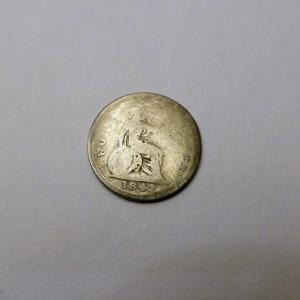These silver threepence coins are slightly larger than the Third of a Farthing which I showed last week for the TinyTuesday challenge and each of these would be equivalent to 36 of the other coin.
It used to be the tradition to put a silver threepence in the Christmas pudding and I used to put one in our neeps and tatties to go with the haggis, partly to get my children to eat up.
By the end of George V's reign the silver threepence had become unpopular in England because of its small size and the larger nickel-brass twelve sided coin was introduced although the silver coins continued to be minted until 1945.
My coins show one with the ‘young head’ of Queen Victoria, a later Victorian coin with the crown and wreath and one introduced in 1927 with the three oak sprigs with three acorns. The other silver coin has the image of a shield of St George lying on a Tudor rose. The larger coins show a three-headed thrift plant and then a Tudor portcullis with chains and a coronet. I wonder if you have any idea why I chose to put a current 10 pence with these 8 threepences. (answer is at the bottom)
Following decimalisation in 1971 the threepence coins ceased to be legal tender.
While searching through my coins I noticed one which I found hard to identify as it was in very poor condition. On researching it I find that this tiny coin (extra) which is the same size as the silver threepence is a groat or a fourpence coin which was issued in 1843. Until then groats had been common but they ceased to be made after 1856 because of the confusion with the similar sized threepence. There were two kinds of groat, one being the Maundy Groat which was not for public use and the other was the Britannia Groat. It was sometimes called a Joey after the MP Joseph Hume who campaigned for its introduction as it would be particularly handy for paying the handsom cab fare of fourpence so did not need the change as a sixpence did. The cab drivers were not happy as they had often been given the twopence change as a tip.
(The eight coins are the equivalent to the modern 10 pence)

Comments
Sign in or get an account to comment.


